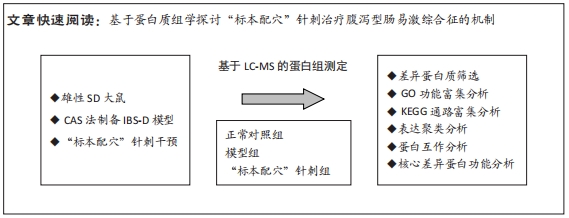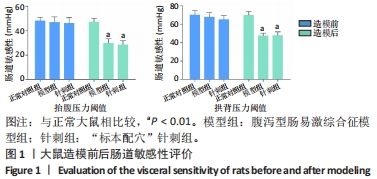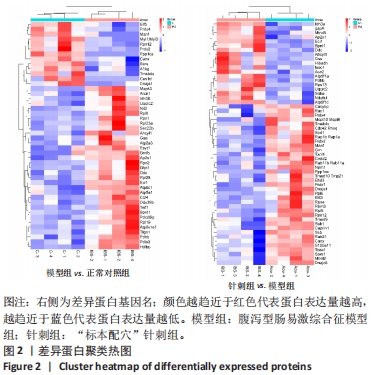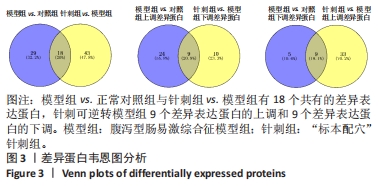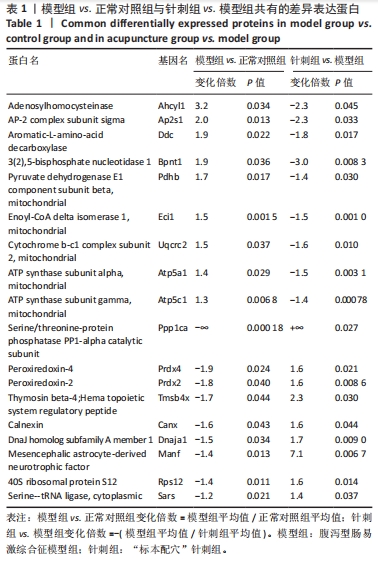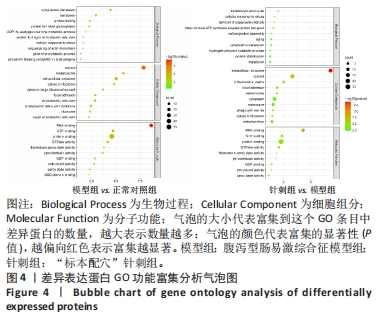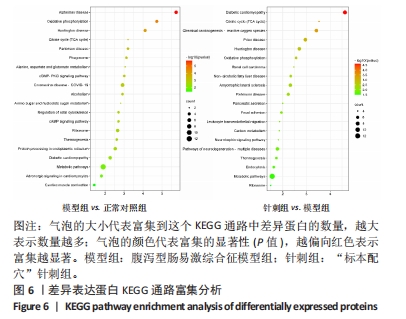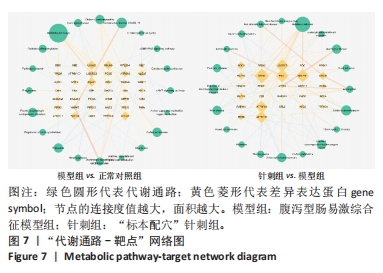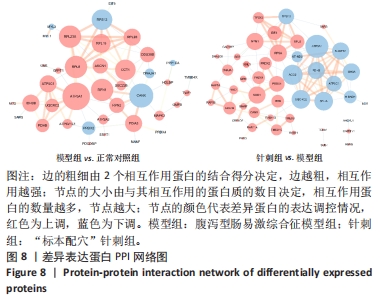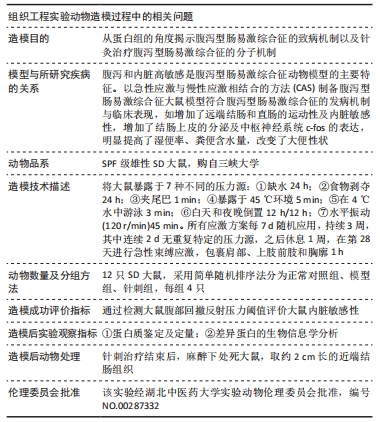[1] IKECHI R, FISCHER BD, DESIPIO J, et al. Irritable bowel syndrome: clinical manifestations, dietary influences, and management. Healthcare (Basel). 2017; 5(2):21.
[2] LI J, YUAN B, LI G, et al. Convergent syndromic atrophy of pain and emotional systems in patients with irritable bowel syndrome and depressive symptoms. Neurosci Lett. 2020;723:134865.
[3] 戎新倩, 舒青龙. 基于脑-肠-微生物轴的肠易激综合征机制与治疗研究进展[J/OL]. 微生物学通报,2023. doi: 10.13344/j.microbiol.china.230253.
[4] CARBONE F, VAN DEN HOUTE K, BESARD L, et al. Diet or medication in primary care patients with IBS: the DOMINO study - a randomised trial supported by the Belgian Health Care Knowledge Centre (KCE Trials Programme) and the Rome Foundation Research Institute. Gut. 2022;71(11):2226-2232.
[5] WU IXY, WONG CHL, HO RST, et al. Acupuncture and related therapies for treating irritable bowel syndrome: overview of systematic reviews and network meta-analysis. Therap Adv Gastroenterol. 2019;12:1756284818820438.
[6] SHI YZ, TAO QF, QIN D, et al. Acupuncture vs. antispasmodics in the treatment of irritable bowel syndrome: An adjusted indirect treatment comparison meta-analysis. Front Physiol. 2022;13:1001978.
[7] BAO C, WU L, SHI Y, et al. Long-term effect of moxibustion on irritable bowel syndrome with diarrhea: a randomized clinical trial. Therap Adv Gastroenterol. 2022;15:17562848221075131.
[8] 张艳佶, 陈祥林, 杨丹, 等. 针灸治疗腹泻型肠易激综合征的网状Meta分析[J]. 针灸临床杂志,2022,38(7):53-59.
[9] 李方文卉, 唐宏图. “标本配穴”电针对腹泻型肠易激综合征模型大鼠内脏高敏感性及紧密连接相关因子的影响[J]. 针灸临床杂志,2021,37(10):71-76.
[10] 付伊萌. 基于代谢组学技术探究标本配穴针灸防治腹泻型肠易激综合征的效应机制[D]. 武汉:湖北中医药大学,2022.
[11] LI Y, PENG S, LIANG F, et al. Effectiveness of acupuncture for irritable bowel syndrome: Protocol for a scoping review of systematic reviews and meta-analyses.Medicine (Baltimore). 2022;101(29):e29218.
[12] LI J, LU W, LI YC, et al. Electroacupuncture Attenuates Depressive Disorder and Gastrointestinal Dysfunction in Myocardial Hypertrophy via Upregulation of 5-HT on Rats. Acupuncture & Electro-Therapeutics Research. 2022;47(3): 356-367.
[13] 李佳, 薛艳, 杨大业,等. 电针足三里穴对肠易激综合征大鼠平滑肌收缩功能及皮层肌动蛋白表达的影响[J]. 广州中医药大学学报,2018,35(2):272-276.
[14] 刘娇萍, 杨大业, 冉国平, 等. 电针足三里穴对肠易激综合征大鼠平滑肌收缩蛋白vimentin的影响[J]. 吉林中医药,2018,38(8):940-943.
[15] LI S, FEI G, FANG X, et al. Changes in Enteric Neurons of Small Intestine in a Rat Model of Irritable Bowel Syndrome with Diarrhea. J Neurogastroenterol Motil. 2016;22(2):310-320.
[16] 郑苏,胥婧,彭力. 电针足三里对肠易激综合征大鼠胃肠功能及CGRP、SP、VIP影响研究[J]. 针灸临床杂志,2018,34(3):66-69.
[17] 中国针灸学会.实验动物常用穴位名称与定位第2部分:大鼠[J]. 针刺研究, 2021,46(4):351-352.
[18] MINOWA T, OHTSUKA S, SASAI H, et al. Proteomic analysis of the small intestine and colon epithelia of adenomatous polyposis coli gene-mutant mice by two-dimensional gel electrophoresis. Electrophoresis. 2000;21(9):1782-1786.
[19] COX J, MANN M. MaxQuant enables high peptide identification rates, individualized p.p.b.-range mass accuracies and proteome-wide protein quantification. Nat biotechnol. 2008;26(12):1367-1372.
[20] BAI T, XIA J, JIANG Y, et al. Comparison of the Rome IV and Rome III criteria for IBS diagnosis: A cross-sectional survey. J Gastroenterol Hepatol. 2017;32(5):1018-1025.
[21] ALTOMARE A, DI ROSA C, IMPERIA E, et al. Diarrhea Predominant-Irritable Bowel Syndrome (IBS-D): Effects of Different Nutritional Patterns on Intestinal Dysbiosis and Symptoms. Nutrients. 2021;13(5):1506.
[22] ZHANG B, XUE H, WANG W, et al. Comparative proteomic analysis of the brain and colon in three rat models of irritable bowel syndrome. Proteome Sci. 2020; 18:1.
[23] 吴帆,王华,吴松,等.王华教授运用“标本配穴”针灸法治疗肠腑病证经验[J].时珍国医国药,2021,32(3):729-731.
[24] 梁众擎, 赵霞, 邢琼琼,等. 基于系统生物学的中医药发展探析[J].中华中医药杂志,2019;34(12):5537-5539.
[25] GOO YA, CAIN K, JARRETT M, et al. Shulman and Margaret Heitkemper. Urinary proteome analysis of irritable bowel syndrome (IBS) symptom subgroups. J Proteome Res. 2012;11(12):5650-5662.
[26] PATEL SA, PATEL N, OKWU V, et al. Analysis of exhaled volatile organic compounds reveals new biomarkers for irritable bowel syndrome. Am Coll Gastroenterol (ACG), 2014, Annual Scientific Meeting: Abstract 12.
[27] 李依洁. 基于脑-肠互动温肾健脾法干预腹泻型肠易激综合征的蛋白组学研究[D].北京:北京中医药大学,2017.
[28] SPILLER R, AZIZ Q, CREED F, et al. Guidelines on the irritable bowel syndrome: mechanisms and practical management. Gut. 2007;56(12):1770-1798.
[29] FORD AC, SPERBER AD, CORSETTI M, et al.Irritable bowel syndrome. Lancet. 2020;396(10263):1675-1688.
[30] MANABE N, WONG BS, CAMILLERI M, et al. Lower functional gastrointestinal disorders: evidence of abnormal colonic transit in a 287 patient cohort. Neurogastroenterol Motil. 2010;22(3):293-e82.
[31] YI L, SUN H, ZHANG H, et al. Down-regulation of HTR1Amodulated ACC activation contributes to stress-induced visceral hyperalgesia in rat. Neurogastro enterol Motil. 2019;31(8):e13620.
[32] QI Q, CHEN F, ZHANG W, et al. Colonic N-methyl-d-aspartate receptor contributes to visceral hypersensitivity in irritable bowel syndrome. J Gastroenterol Hepatol. 2017;32(4):828-836.
[33] 邰昭霞,费雪瑜,瞿思颖,等. 电针对糖尿病神经痛大鼠脊髓背角NF-κB p65蛋白的干预作用[J]. 中国实验动物学报,2020,28(1):43-48.
[34] FISCHER SG, PEREZ RS, NOUTA J, et al. Oxidative stress in Complex Regional Pain Syndrome (CRPS): no systemically elevated levels of malondialdehyde, F2-isoprostanes and 8OHdG in a selected sample of patients.Int J Mol Sci. 2013; 14(4):7784-7794.
[35] 李晓洁,尹诚语,郑小莉,等. 电针对复杂性区域疼痛综合征I型大鼠模型局部组织氧化应激反应的干预作用[J]. 中国实验动物学报,2020,28(5):593-601.
|
